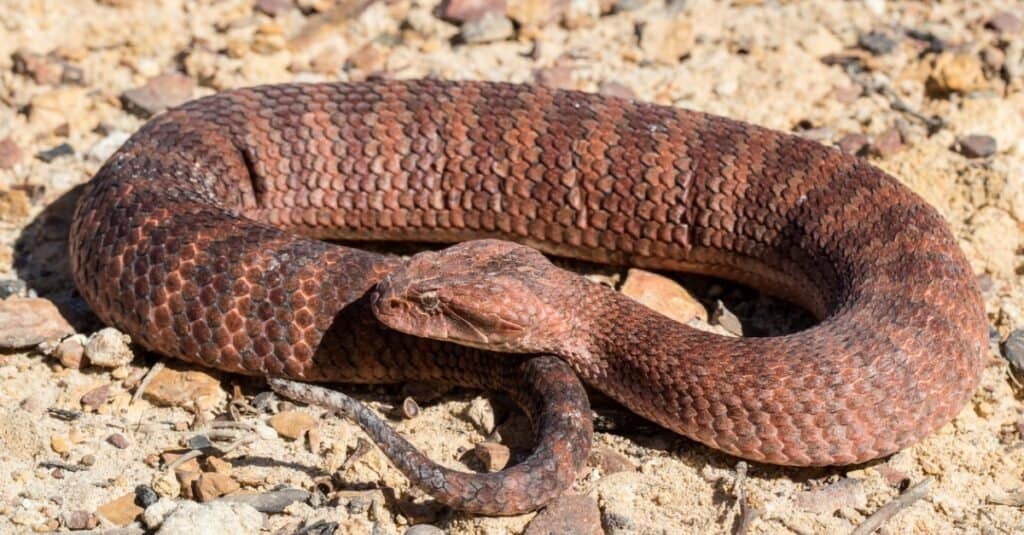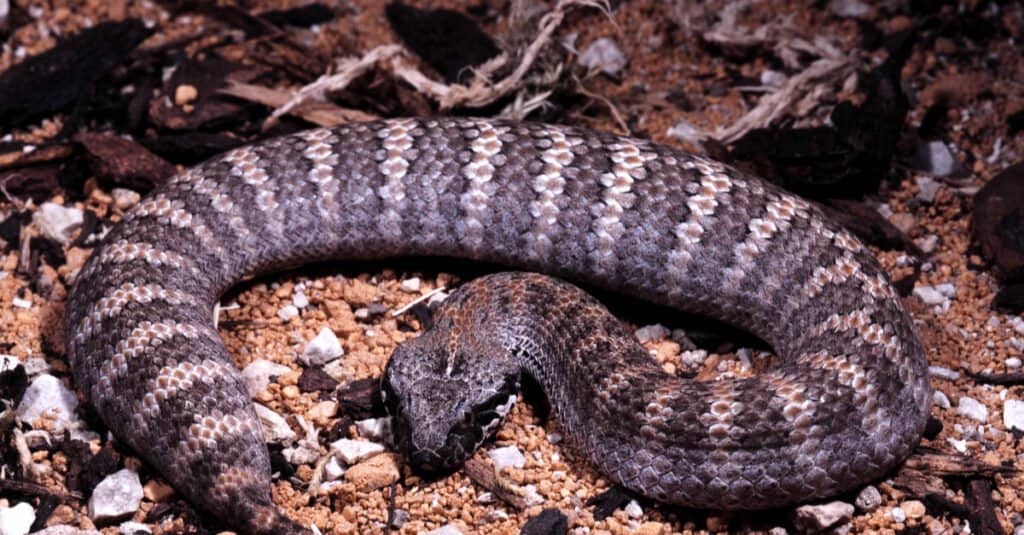Death adders have quite an infamous reputation in the reptile world. Also called common adders, they have one of the deadliest snake venom known to man. They aren’t pit vipers, as many assume, but belong to the elapid snake family.
In addition to their deadly venom, these snakes are also fast. Unlike other snakes, they may not give any warning sign before striking. Death adders measure 27.6 inches on average, but some species exceed this mark. In this article, you will discover the largest death adder ever recorded.
Death Adders (Acanthophis antarcticus)

The common death adder has the longest fangs of any venomous Australian snake.
©iStock.com/Ken Griffiths
Death adders are venomous elapids known for their dangerous venom and quick bites. They are carnivores and feed on small mammals as well as birds and their eggs on occasion. Unlike common European vipers, death adders are not pit vipers. In fact, most adders are only distantly related -if at all- and do not belong to the same snake family. Puff adders, for example, are colubrids majorly found in Africa.
Death adders are related to cobras, and many claim that this is the origin of their name – they are as deadly as cobras. According to the ITIS (Integrated Taxonomic Information System), there are two subspecies of common death adders; Acanthophis antarcticus antarcticus and Acanthophis antarcticus schistos. However, scientists have discovered a new subspecies of death adder; the Kimberly death adder.
The Kimberley death adder (Acanthophis cryptamydros) is commonly found in Northwestern Australia. Richard Wells and Ross Wellington, two Australian herpetologists, named the new Kimberly death adder subspecies the “Acanthophis lancasteri.”
Generally, death adders are not aggressive, and they are quick to hide and camouflage in the wild to avoid being seen. Death adders will only bite as a last resort and are more likely to strike with dry bites. Like many snakes, they are most active in the afternoon when the sun is out and temperatures are generally warmer.
Where Are Death Adders Found?

The common death adder is native to Australia.
©Vladislav T. Jirousek/Shutterstock.com
Death adders are native to Australia. They are commonly spotted in its coastal southern and eastern parts such as South Wales, Queensland, Victoria, as well as South and New Australia.
There have also been reports of them in Western Australia and the western parts of Southern Australia. Death adders are also infrequently spotted in Papua Island and the Northern Territory. Generally, these snakes are found in grasslands, forests, shrublands, and woodlands.
Identifying A Death Adder
Death adders are heavy animals. Their bodies are made of bands colored brown, red, and black, and their bellies are colored pink, cream, or gray. These snakes have broad and flattened triangular heads. On average, death adders measure from 2.3–3.3 feet (27.6 to 39.6 inches). They are also known to have the longest fangs of any snake in Australia.
What is the Largest Death Adder Ever Discovered?

The maximum length death adders attain is 3.3 feet or 39.6 inches.
©Ken Griffiths/Shutterstock.com
Currently, there isn’t any official record of any death adder specimen recognized as the largest. However, the maximum lenght these snakes attain is 3.3 feet or 39.6 inches, so if you spot a death adder snake longer than this, be sure to get it on record. Your find might make the record books.
Death Adder Bite
Death adders are extremely quick to bite and can bite in 1/10th of a second (100 milliseconds). Despite having proteroglyphous fangs like all elapids, their fangs are long and measure 6.2mm on average.
Check out this really short YouTube video by Discover Deadly showing just how fast these snakes can bite.
Death adders do not always inject venom, as dry bites are very commonly reported. However, this is not the rule as several people have died from death adder bites. Some immediate effects of their bites are swelling, pain, and envenomation.
Death Adder Venom
Death adders have primarily neurotoxic venom. Neurotoxic venom is one of the fastest-acting venom and is known to attack the nervous system and lead to paralysis. On average, death adders inject 85 mg of venom, making them extremely high yielders. Considering that only 10 mg of death adder venom is enough to kill a human, these snakes are extremely deadly.
Their maximum venom yield is 235 mg, and the minimum amount of venom they are known to inject in their dry bites is 2mg. Dry or warning bites occur about 40% of the time. It is alleged that 40% of death adder bites used to be fatal before an anti-venom was created.
Death Adder Reproduction
Female death adders are ovoviviparous and reproduce once every two years. On average, they give birth to 10 to 20 young ones per cycle. However, some female death adders have been reported to have up to 30 young ones at a single time. Death adders mate in the spring and give birth to their young in the autumn.
Are Death Adders Deaf?
Deaf adders aren’t any more deaf than other snakes. Snakes do not have external ears. Instead, they “hear” by feeling vibrations in the ground. It is believed that the origin of this misconception is the death adder’s behavior toward humans.
When they are discovered or spotted and sense humans coming closer, they freeze in a bid to camouflage- like copperheads. This made people believe that they did not hear humans when they approached. Many people believe that death adders were originally called “deaf adders” which eventually transformed into death adders.
What To Do If You Get Bitten By A Death Adder?
If you get bitten by a death adder, stay calm and take the following steps:
- Contact emergency services immediately
- Do not cut off the bitten part. You could make the situation worse
- Do not attempt to suck out the venom or apply a tourniquet. These could also aggravate the situation.
- Stay calm and do not move around, as this can aid the circulation of the venom.
- Remain calm and wait for help without attempting to treat yourself.
The photo featured at the top of this post is © Adam Brice/Shutterstock.com
Discover the "Monster" Snake 5X Bigger than an Anaconda
Every day A-Z Animals sends out some of the most incredible facts in the world from our free newsletter. Want to discover the 10 most beautiful snakes in the world, a "snake island" where you're never more than 3 feet from danger, or a "monster" snake 5X larger than an anaconda? Then sign up right now and you'll start receiving our daily newsletter absolutely free.
Thank you for reading! Have some feedback for us? Contact the AZ Animals editorial team.






